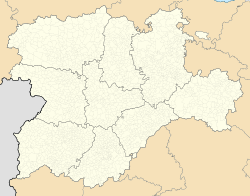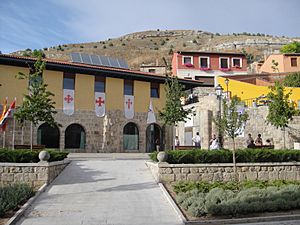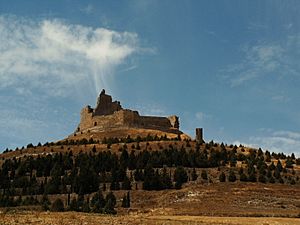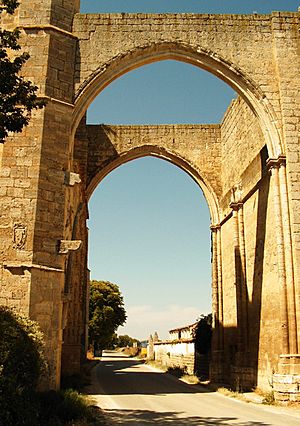Castrojeriz facts for kids
Quick facts for kids
Castrojeriz
|
||
|---|---|---|
|
Municipality and town
|
||
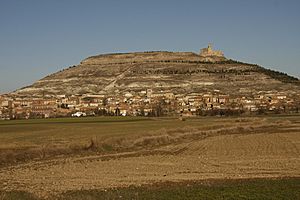
View of Castrojeriz, 2010
|
||
|
||
| Autonomous community | ||
| Province | ||
| Comarca | Odra-Pisuerga | |
| Founded | 882 | |
| Area | ||
| • Total | 136 km2 (53 sq mi) | |
| Elevation | 804 m (2,638 ft) | |
| Population
(2018)
|
||
| • Total | 803 | |
| • Density | 5.904/km2 (15.29/sq mi) | |
| Postal code |
09110
|
|
| Area code(s) | 947 | |
| Website | Castrojeriz city council | |
Castrojeriz or Castrogeriz is a small town and municipality in the province of Burgos, in the region of Castile and León in Spain. It's part of the Odra-Pisuerga area.
This town is a very popular stop along the French Way of the Camino de Santiago. This famous walking path, also known as The Way of Saint James, goes right through the middle of Castrojeriz for over 1,500 meters!
Contents
History of Castrojeriz
Castrojeriz is located near the Odra River. This river later joins the Pisuerga river. Long ago, between 1785 and 1833, Castrojeriz was an important area. It was one of fourteen special districts that made up the Province of Burgos.
People believe Castrojeriz was once called Castrum Sigerici. The town is set up like many other villages along the Camino de Santiago. Its main street has several old churches and important buildings. There is also a castle, which is now in ruins, but has a very long history.
The town was founded by Count Muño (or Nuño Nuñez). He defended the fort against the Arabs in the late 800s. Even before that, it was a fortress used by Celtiberians, Romans, and Visigoths.
In 974, Count García Fernández of Castile gave Castrojeriz a special document. This document was called the Charter of Castrojeriz. It is thought to be the very first charter ever given in Castile.
Historically, a Jewish community lived in Castrojeriz. In 974, the same year the town got its charter, Count García Fernández made a rule. He said that the fine for harming a Jewish person should be the same as for harming a Christian farmer. This shows that the Jewish community in Castrojeriz was one of the earliest recorded in Spain. This community later left the town after 1492.
Castrojeriz is a great example of a "Jacobean" town. This means its houses are built around the main street, which is part of the Camino de Santiago. This street is the longest main street on the entire pilgrimage route! Because it was such an important stop, it had several hospitals along this street. These hospitals helped pilgrims who were sick or tired.
You can also find a special monument called a calvary here. It has a Cross of Tau (Tau) instead of the usual cross. This might remind people of the Order of the Antonians. They had a monastery and hospital nearby. They helped sick people, especially those with a disease called St. Anthony Fire. We now know this disease was caused by eating rye grain that had a harmful fungus on it.
Population
As of January 1, 2010, the town of Castrojeriz had 882 people living there. Out of these, 447 were males and 435 were females.
Historical Buildings and Sites
The Village as a Whole
The entire village of Castrojeriz is considered a Bien de Interés Cultural. This means it's a very important historical site. It's also listed as a "Conjunto histórico," which means a historical group or set of buildings. This is because it's a key part of the Camino de Santiago. It was officially recognized as important on December 20, 1974.
The Castle of Castrojeriz
The Castle of Castrojeriz is also a "Bien de Interés Cultural." It was recognized on April 22, 1949.
In 1359, a sad event happened here. Queen Eleanor of Castile was murdered at the castle. She was the daughter of King Ferdinand IV of Castile and the wife of King Alfonso IV of Aragon. Her nephew, Pedro of Castile, ordered her death.
Church of San Juan
The Church of San Juan is another important historical site. It was recognized on November 21, 1980.
The church building you see today was built for several important families to be buried there. Here are some interesting parts:
- Sixteenth-century cloister: This is a covered walkway with arches. It still has three sections. The ceiling is made in a special style called Mudejar. It has designs with stars and planets, and the family symbols of the Gómez Sandovals. You can also see some cross designs that might be from the Knights Templar.
- Funeral chapel: This chapel was built by Juan Gonzalez Gallo. It has a beautiful altarpiece (a decorated screen behind the altar) with 12 paintings. These paintings are thought to be by an artist named Ambrosius Benson.
- Castro-Mujica Chapel: This chapel has a Gothic-style tomb for Diego Mújica, who died in 1527. His statue is shown lying down, and his family symbols are on the tomb.
- Main altarpiece: This large, golden altarpiece was made in the 1700s in the Rococo style (a fancy, decorative art style). It was originally made for the San Antón Convent in town. It was moved to the Church of San Juan later.
- Choir loft: This is a raised area for singers. It has railings and stairs with beautiful Gothic designs.
Iglesia de Nuestra Señora del Manzano
Ruins of the San Antón Convent
Just outside Castrojeriz, you can find the ruins of the old San Antón monastery. This was once a palace and garden belonging to King Pedro I of Castile. The monastery was run by the Hospital Brothers of St. Anthony. They took care of sick pilgrims on the Camino de Santiago. They were especially known for treating "St. Anthony's fire," a disease caused by a fungus on rye grain.
Today, only a large arch remains. This arch once formed a tunnel that pilgrims walked through.
This monastery was very important and had royal protection. You can see royal symbols on the front of the church and on the archways. It was founded by King Alfonso VII in 1146. It was known as the "royal xenodoquio of San Antonio Abad." The ruins you see today are from the 1300s. The hospital was a major center for the Order of San Antonio in Spain and Portugal. The monks of this order used the tau cross as their symbol.
Famous People from Castrojeriz
- Constance of Castile, Duchess of Lancaster (1354-1394): She was born in Castrojeriz in July 1354. She was the second daughter of Peter the Cruel, who was King of Castile. She married John of Gaunt, who was a Duke and the third son of King Edward III of England.
- Laín Calvo (around 798 - 870): He was born in Castrojeriz. He was a very important judge in Castile.
See also
 In Spanish: Castrojeriz para niños
In Spanish: Castrojeriz para niños




